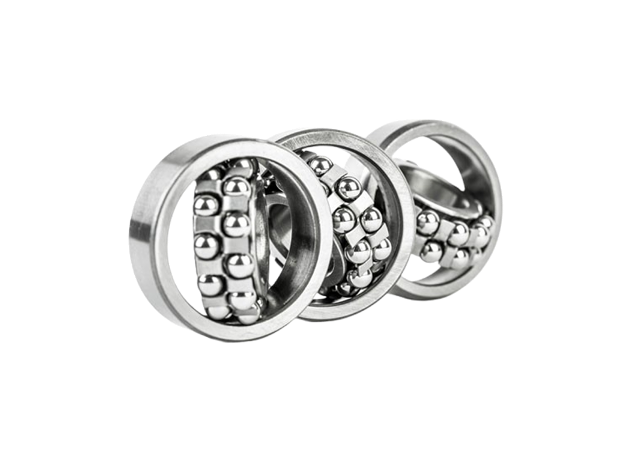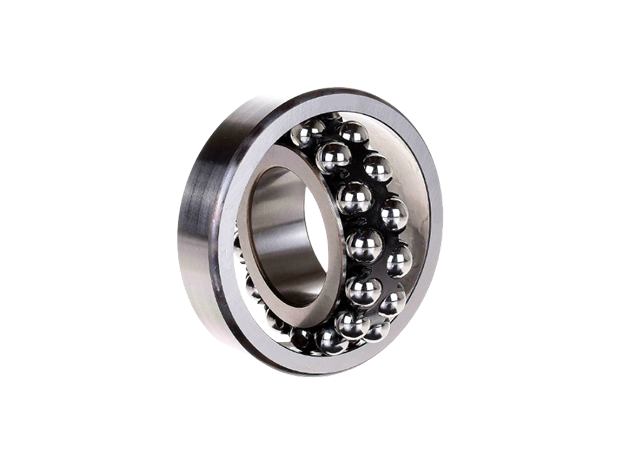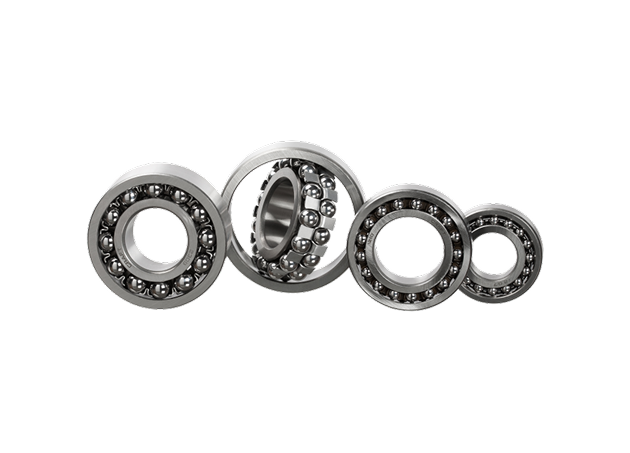Home / Product / Ball Bearings / Self Aligning Ball Bearings
Self Aligning Ball Bearings
TFL’s self aligning ball bearings are designed to accommodate misalignment in automation and machine tools. Our self-aligning ball bearing range offers flexibility and durability, ensuring smooth performance in dynamic conditions.

What makes these bearings “self-aligning”? TFL utilizes a unique design featuring a spherical raceway in the outer ring.
This allows the inner ring, complete with two rows of balls and the cage, to freely tilt or self-align relative to the outer ring, compensating for alignment errors.
Loading...
Total 1932 Results
Part Number
Bore Dia
Outer Dia
Width
System of Measurement
For Load Direction
Dynamic Radial Load
Static Radial Load
Weight
Price($)
1300J
10 mm
30 mm
14 mm
Metric
Thrust
700 lbf
2718 lbf
0.04 kg
2200
10 mm
30 mm
14 mm
Metric
Radial
8665 lbf
71890 lbf
0.048 kg
12.63
2200 E-2RS1TN9
10 mm
30 mm
14 mm
Metric
Radial
8665 lbf
71890 lbf
0.048 kg
29.7
2200 E-2RS1TN9/W64F
10 mm
30 mm
14 mm
Metric
Radial
8665 lbf
71890 lbf
0.048 kg
70.08
2200 ETN9
10 mm
30 mm
14 mm
Metric
Radial
8665 lbf
71890 lbf
0.047 kg
13.81
2200 ETN9/W64
10 mm
30 mm
14 mm
Metric
Radial
8665 lbf
71890 lbf
0.047 kg
2200-2RS
10 mm
30 mm
14 mm
Metric
Radial
8665 lbf
71890 lbf
0.048 kg
30.39
S2200-2RS-TV
10 mm
30 mm
14 mm
Metric
Radial
8665 lbf
71890 lbf
0.048 kg
2200-2RS-TVH
10 mm
30 mm
14 mm
Metric
Radial
1244 lbf
266 lbf
0.048 kg
27.11
2200-2RSR
10 mm
30 mm
14 mm
Metric
Radial
1244 lbf
266 lbf
0.048 kg
2200-TVH
10 mm
30 mm
14 mm
Metric
Radial
1244 lbf
266 lbf
0.048 kg
22.61
2200-TVH-C3
10 mm
30 mm
14 mm
Metric
Radial
1244 lbf
266 lbf
0.048 kg
22.61
2200J
10 mm
30 mm
14 mm
Metric
Radial
1244 lbf
266 lbf
0.048 kg
24.61
2200TNH
10 mm
30 mm
14 mm
Metric
Radial
1244 lbf
266 lbf
0.048 kg

Design and Functionality of Self-Aligning Ball Bearings
The core design of self-aligning ball bearings consists of two rows of balls sharing a common sphered raceway in the outer ring. This geometry is key to their function. It permits the inner ring assembly to swivel within the outer ring, automatically accommodating initial static angular misalignment that might arise from machining inaccuracies or shaft deflection under load.
Key Benefits and Typical Applications
The primary advantage of using a self-aligning bearing is its ability to tolerate misalignment without inducing excessive stress or reducing bearing life. This makes self-aligning ball bearings particularly suitable for applications involving long shafts that are prone to deflection, non-rigid housings, agricultural machinery, fans, conveyors, and textile machinery where maintaining perfect alignment can be challenging.


Selection Considerations and Sizing
When selecting self-aligning ball bearings, it’s important to consider the load capacity (they typically handle lower loads than deep groove ball bearings of the same size) and speed limitations. Using a self-aligning ball bearing size chart is crucial for identifying the correct dimensions (bore, OD, width) for your application. TFL offers these bearings in various sizes, both open and with seals, to meet diverse operational requirements.
FREQUENTLY ASKED QUESTIONS

Can self aligning ball bearings support heavy loads?
Self aligning ball bearings are best for radial loads and moderate axial loads in systems with misalignment, like textile looms or conveyor belts. While they’re not meant for super heavy loads like some other bearings, their strength lies in adapting to shifting conditions, such as in agricultural equipment or fans with variable forces. They keep things running smoothly under typical industrial demands, reducing downtime and maintenance hassles for reliable operation.
What causes the misalignment that these bearings accommodate?
Misalignment can stem from several sources, including manufacturing tolerances in housings, inaccuracies during machine assembly, or shaft deflection caused by operational loads or temperature variations. Self aligning ball bearings are designed to manage these common issues.
How much misalignment can a typical self-aligning ball bearing handle?
Standard self-aligning ball bearings can typically accommodate static misalignment of roughly 2 to 4 degrees, depending on the specific series and size. However, always consult the manufacturer's specifications (like those provided by TFL) for precise limits.
Are different sizes of self aligning bearing available?
Yes, TFL offers various self aligning ball bearing sizes; check our self-aligning ball bearing size chart for precise options.